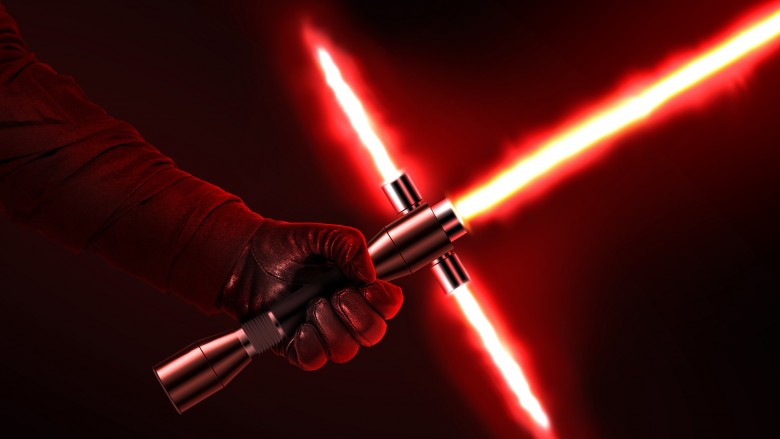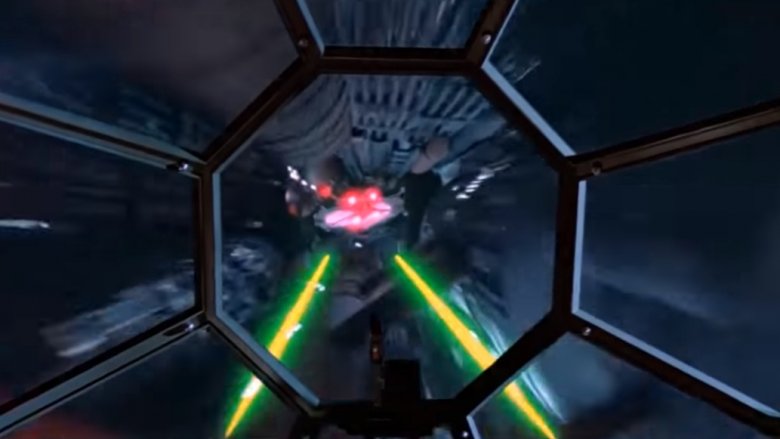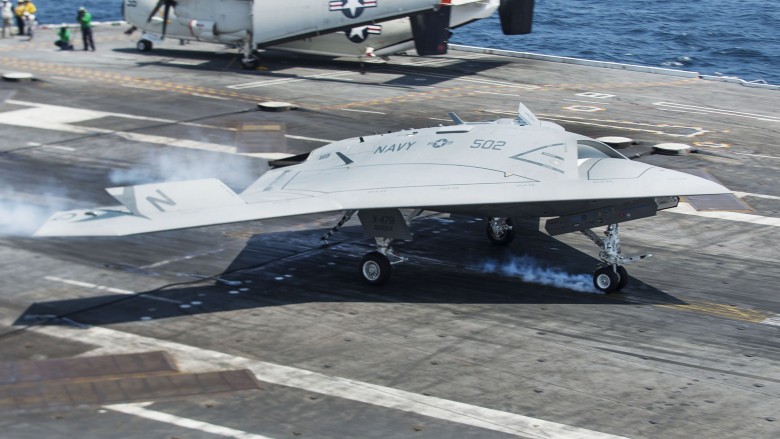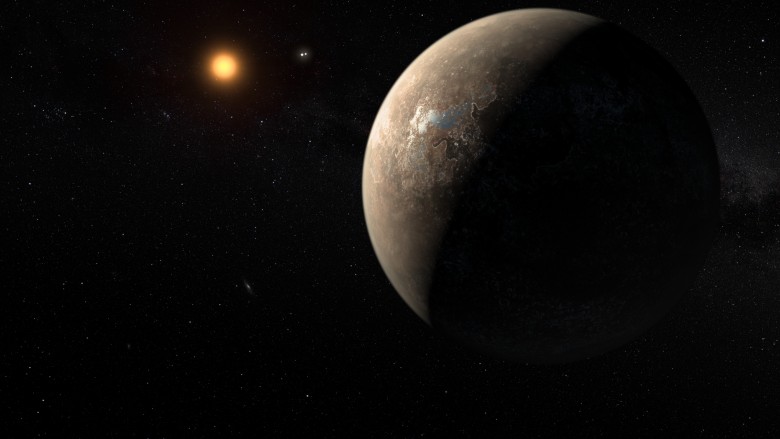Star Wars Science That Actually Exists In Real Life
Star Wars tech is super-cool, but we usually have to accept that it only exists in the movies. However, some scientists and engineers aren't content on letting that happen, and have worked to create tech that resembles the stuff we see in the Star Wars movies.
Lightsabers
Watching epic lightsaber battles in the movies is exciting, but everybody knows a sword made of light just can't work. Photons of light can't stop in mid-air or interact with other photons to create objects, doii.
Well, maybe it's not true. Photons normally don't do that, but researchers at MIT and Harvard have discovered a way to make light behave like lightsabers, called photonic matter. The science behind photonic matter is intricate and complex, so we'll spare you the gory details. Basically, photons have no mass, so they can't interact with each other like electrons and protons do. That is, unless you shoot them through supercooled rubidium gas.
When a photon enters the gas it slows down, losing energy as it bounces off rubidium atoms. If another photon enters the gas, it puts more energy into the system, pushing the original atom through the gas, so they're technically interacting like they have mass. It's like the photons turn into a mass of Black Friday shoppers trying to squeeze through the doors of Walmart, with the people behind them pushing them forwards.
Photonic matter isn't just a cool science experiment — it has real life implications. Since the light is acting like a molecule, it can get shaped into whatever scientists want. Researcher Mikhail Lukin has proposed making crystals out of pure light and, once you're making crystals, it's not a far step to "sword made of light." Get ready for epic Jedi battles in our future.
Ship-based lasers
One of the coolest parts of Star Wars is the space battles, with the Millennium Falcon and big capital ships bombarding each other with laser weaponry and torpedoes. While big engagements like the Battle of Endor are a long ways off, the US Navy is already putting laser weapons on their ships.
Getting the perfectly descriptive name "Laser Weapon System" (LaWS), the Navy has tested this new weapon for years. For now, it isn't designed for massive broadside battles, but rather for point defense. LaWS can intercept incoming anti-ship missiles or enemy drones, heating up their exterior with laser light until they explode. LaWS is also capable of disabling small boats that are violating the laws of the sea. By the by, this isn't just some research test — LaWS already saw deployment to the Middle East in 2014.
Not content with letting the Navy take all the science fiction glory, the other branches of the US military have started testing laser weapons. The Army has a truck mounted laser, while the Air Force has tested a pulse laser, capable of shooting small bursts of laser energy, which sounds an awful lot like X-wing weaponry. Of course, all these lasers shoot invisible beams — for the time being, future combat won't have conveniently color-coded red and green lasers to show us who the bad guys are.
Autonomous fighter planes
In the prequels, we saw vast armies of CGI robots, ranging from foot soldiers to space fighters. The militaries of the world haven't create huge armies of robots (if Terminator taught us anything, it's that this would be a bad idea) but they do use unmanned aerial vehicles to do missions too dangerous for human pilots. UAVs like the Predator drones still need a human operator to fly them, but Northrop Grumman wants to change that through their experimental X-47B, an autonomous robot fighter.
Looking like a miniature version of Grumman's iconic B-2 stealth bomber, the X-47B does Naval operations. Its advanced systems can complete the same missions that the Navy's manned fighter planes do, but without the danger to human pilots. But the X-47B isn't just a missile truck. Unlike other drones, it's incredibly smart, capable of flying missions all on its own without a human supervising it.
Already the X-47B has completed a number of feats once considered impossible for robots. It's flown formation with human-piloted fighter planes, and even landed on an aircraft carrier all by itself. Landing on a carrier rocking around in an ocean, while flying at high speed, is hard enough for a human pilot, but now robots can do it just as well.
For now, the X-47B is just a technology demonstrator, but it has proved that autonomous robot fighters work, and they work well. Hopefully they stay on our side — flight crews have nicknamed the X-47B "Cylon" which is a ... little concerning.
Universal translator devices, like C-3PO
Translating between human languages is hard enough — translating between alien languages would be nearly impossible. That's why, in the Star Wars universe, dedicated translator robots like C-3PO exist. Somebody has to make sure all the species can talk to each other — how else is an undercover Leia supposed to do business with Jabba the Hutt?
Forgetting future intergalactic diplomacy for a moment, a version of C-3PO on Earth would be insanely helpful. Various tech companies around the world are already working on the problem, hoping to facilitate communication across cultures. The key is neural networks. A universal translator needs to have a network like the human brain to decode the source language and translate it into another. Researcher Geoffrey Hinton believes that, with recent developments in artificial intelligence, we're not too far off.
Waverly Labs thinks they've figured it out without using artificial intelligence. They built the Pilot Earbuds, a system that runs through a smartphone and deciphers languages. When two parties are wearing the earbuds, a Bluetooth interface will run between them, translating the language directly into audible words. Details on how the Pilot works are still scarce, but it is one step closer to a real-life C-3PO. Hopefully the earbuds don't start developing a prissy attitude like the golden robot, though.
Electromagnetic propulsion drives
Star Wars ships don't rely on the brute force of giant rockets, like our spaceships do. They use electromagnetic propulsion or other forms of exotic thrust. If the human race wants to fulfill its Star Wars dreams, it will need to get past rocket propulsion and find something new. We need a lightweight, powerful engine that doesn't need huge fuel tanks to work. Cutting-edge British scientist Roger Shawyer might have figured out how. Shawyer calls his device the EmDrive, and it will revolutionize space travel.
The physics behind the EmDrive are complex. Simply put, it converts electricity to thrust by bouncing microwaves around inside of it. Getting into the real nitty-gritty details requires some intense mathematics and physics, so yeah, no thanks. The weird thing is, the EmDrive produces thrust without any detectable exhaust. It's reactionless, which would be like a jet engine working without the fire and heat coming out the back. The EmDrive looks like it violates known physics laws, but Shawyer believes that it produces exhaust in the form of radiation pressure.
If the EmDrive works, it will completely change how we fly in space. A trip to Mars could take only 70 days, fast-tracking colonization efforts to the planet. But does it work? NASA thinks it does. A research team has done work with the EmDrive, showing that the method behind the engine is sound. Now it just needs to get tested in space. NASA is planning on it, but China claims they already have. The Space Propulsion Race is on.
Droids
Artificial intelligence in Star Wars is far more complex than real-life AI. Leading tech researchers aren't about to get beat by a fictional movie series, so they're working as hard as they can to develop robots straight out of Star Wars.
One example is NASA's push to create real-life astromech droids like R2-D2. The idea is that these robot mechanics can work on the International Space Station, taking the load off station astronauts. Robonaut 2 is but one example of NASA's work — this humanoid robot has gone to space and worked on the station to test the feasibility of having robots serve in space. While Robonaut 2 is humanoid shaped, his role still mimics what R2 did in the Star Wars movies.
Other types of Star Wars robots are making their way into our lives. The new Robot Nursing Assistant helps physicians by handling surgical tools much more precisely than any human doctor can. Self-driving cars are similar to the robot pilots in the movies and Expanded Universe franchise. As you can see, more robots hit the market every year, slowly transforming our world into something straight out of science fiction. Hopefully the robots follow the example of Star Wars, and not that of Battlestar Galactica or Terminator.
Luke's prosthetic arm
When Luke lost his hand in Empire Strikes Back, it got replaced by magic space technology. In the '80s, Luke's fictional hand was way better than anything on the market, having enough motor control and neural feedback to let him lightsaber battle, fly space ships, and fight the Rancor. The mad scientists at the Defense Advance Research Project Agency (DARPA) probably were influenced by the movies, because they recently unveiled a robot hand just like Luke's.
The biggest problem with any prosthesis is that it doesn't interact with the brain. It's a useful — but ultimately dead — chunk of plastic. DARPA changed that by using a series of ultra-small electrodes that run from the prosthetic limb into the remaining muscles. All these little electrodes allow neural signals to run through the live arm into the fake one. DARPA's limbs can move and function just like any other limb, and the operator doesn't have to do anything different to make it work.
Even crazier is how these electrodes allow for feedback from the limb. Being able to control the limb is great but, without the sense of touch, amputees would have to rely purely on their eyes to see what the arm's doing. With DARPA's arm, they can regain a limited sense of touch, helpful when rummaging through a bag, doing things in a dark room, or fighting evil emperors.
As soon as the arms hit the market, it will completely revolutionize prosthetic design. Hopefully we won't see an uptick in fathers cutting off their son's limbs with photonic matter lightsabers.
Hyperdrive
All this technology is awesome, but if we really want to live like the Star Wars galaxy, the human race needs to figure out faster-than-light travel. The galaxy is simply too big otherwise — any expedition to a star would take centuries, and the colonists would be essentially cut off from the rest of the human race. Problem is, travelling faster-than-light is impossible, ludicrous even. But, there is a way around it — it's called the Alcubierre Warp Drive, and it's basically a physics cheat code.
An object can't travel faster than light in space, but space itself can travel faster than light. That's a subtle distinction, but an important one that Alcubierre's drive uses. Essentially, what it would do is encase a spaceship in energy. Then, using a negative energy density, it would contract the fabric of space-time in front of the ship, while expanding the fabric behind it. Now the spaceship has a virtual speed greater than light, while in its little warp bubble, it's not travelling faster than light.
There's a lot of technological hurdles to conquer before the Alcubierre drive can work. It requires a ton of energy, way more than accessible by modern tech. It also needs negative energy density to work, an exotic form of energy that has only been discovered in microscopic quantum interactions. Certainly, we'd need more than microscopic quantities for the drive to work, but the theory is sound. We know how to travel faster than light — it's just that building a ship that can do it is an issue. Hopefully one day, we too can make the Kessel run in 12 parsecs.
Walkers
During the Cold War, American firms got funding for just about any crazy idea they had. In the 1960s, the Army was looking for a way to improve mobility, knowing that wheeled and tracked vehicles were unable to work in some climates. The Army called up General Electric, and told them to get cracking on a walking truck. Yes, a walking truck.
It was an ambitious design, using four legs to simulate the way animals walked. Essentially, the Walking Truck was a cybernetic horse. At eleven feet tall and driven like a tank, the Walking Truck was an imposing sight, and General Electric thought they had revolutionized military transportation. Testing, however, soon unveiled key issues. First, it could only reach a top speed of five miles per hour, which was way too slow for a combat vehicle. Secondly, it had huge problems with stability, necessitating awkward stabilizers stuck off to the sides. Essentially, the Walking Truck had the same issues as the AT-AT walkers in Empire Strikes Back. The Soviets just needed harpoons and tow cables to bring them down.
Obviously, the Walking Truck never caught on, but it did capture the imagination of the special effects designers for Star Wars. Inspired by images of the Walking Truck, the production crew of Empire Strikes Back came up with the AT-AT walker. This is one of the few times in Star Wars that the tech was based on something that really existed.
Star Wars-esque exoplanets
Since astronomers discovered the first planet outside our solar system in the early 1990s, the exoplanet field has exploded (and not in the Alderaan way). Every year, more exoplanets get discovered, showing us that the Milky Way galaxy is filled with planets. Just about all of them are uninhabitable, and more than a few look like planets straight out of Star Wars.
Gas giants are extremely common in the galaxy, and many look like the planet Bespin in Empire Strikes Back, covered in orangish gases. The hilariously long-named planet OGLE 2005-BLG-390L is probably a rocky, ice-covered world, like Hoth. Kepler-16b is only 200 light years away and orbits a dual-star system, just like Luke Skywalker's homeworld of Tatooine. (Unfortunately, Kepler-16b isn't a desert world like Tatooine, but a couple of those might exist as well.) On the other side of the spectrum, recently discovered Kepler-22b is most likely covered with a giant planetary ocean, resembling Kamino.
The most interesting exoplanets, however, are those that might support life. Of course, any claims that a planet has life on it is pure speculation, but astronomers can use spectroscopy to figure out the atmospheric composition of an exoplanet. They're looking for rocky worlds at the right distance from their star that have an atmosphere like ours, and a few candidates exist. Kepler-452b is the perfect match — interestingly enough, Kepler-452b is 1.5 billion years older than Earth. If any alien civilization exists on Kepler-452b, it's almost certainly much farther ahead of us technologically (as the Galaxy Far, Far Away clearly is). Hell, they may have even had a few star wars of their own already.





